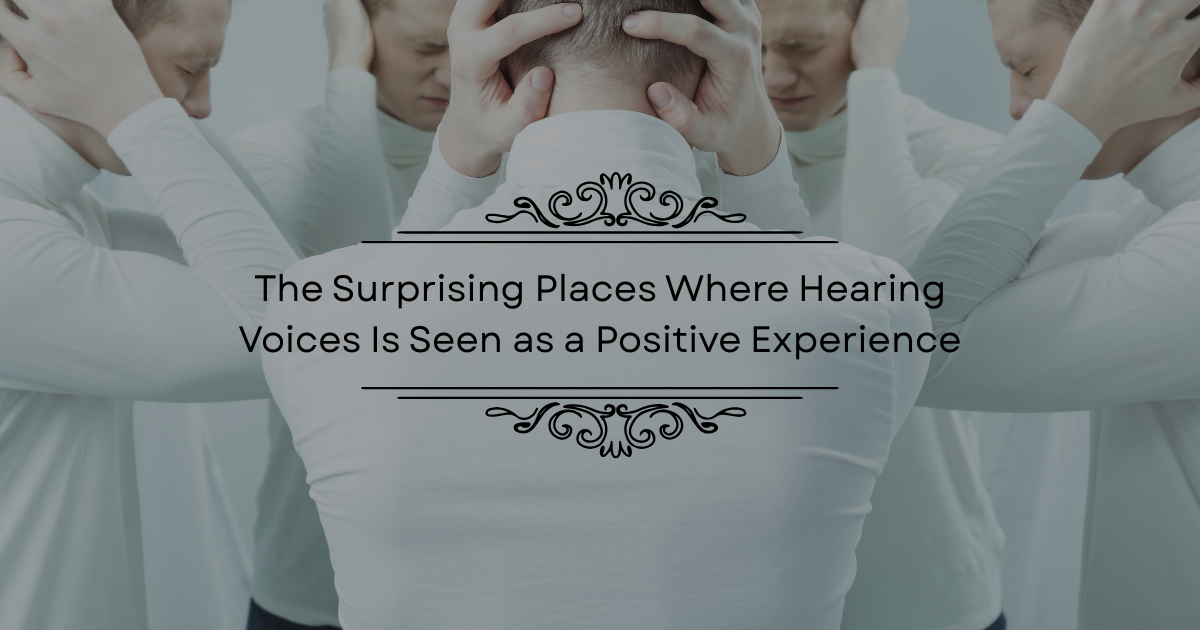In Western medicine, anyone who reports being guided by disembodied voices is typically diagnosed with psychosis. But not all cultures see it that way. Around the world, many communities interpret these experiences through spiritual, cultural, or even positive psychological lenses—raising the question: what can we learn from those who view “hearing voices” differently?
Surprisingly, hearing voices is far more common than most people realize. Decades of research reveal that a significant number of people with no diagnosed mental health condition—sometimes more than three-quarters of participants in studies—report hearing voices that appear to come from an unknown source.
#1In Western psychiatry
auditory hallucinations—commonly described as “hearing voices”—are considered one of the core symptoms of psychotic disorders. Because of this, the stigma surrounding mental illness often prevents people from openly admitting that they experience such voices.
Yet in many cultures around the world, these experiences are not only normalized but sometimes celebrated. Instead of being seen as a sign of illness, they are interpreted as guidance, spiritual communication, or even protection. This contrast raises a key question: what can global perspectives on “hearing voices” teach us about mental health?
According to Tanya Luhrmann, professor of anthropology at Stanford University and co-author of Our Most Troubling Madness, cultural expectations strongly influence how hallucinations are judged. In the US, the DSM-5 lists hearing voices as a primary diagnostic feature of schizophrenia and psychosis. However, the picture is more nuanced: research suggests that up to 80% of bereaved Americans and Europeans report sensing, hearing, or even seeing deceased loved ones—an experience often interpreted as comforting rather than pathological.
Cultural interpretations vary widely. Among the Achuar tribes of Ecuador, mourning is discouraged, and visions of the dead are considered threatening to the living. In the Amazon, the Siona tribe views hallucinations as glimpses of an alternate reality, while the Schuar tribe believes that everyday life is the illusion—and hallucinations reveal true reality.
Even more striking are differences in how people emotionally respond to their voices. A cross-cultural study of patients with psychosis in the US, Ghana, and southern India found that:
Americans were more likely to dislike or fear their voices, often perceiving them as hostile or meaningless.
Participants in Chennai, India, frequently identified the voices as those of family members, offering advice, daily reminders, or even playful scolding. One participant explained, “They talk as older people advising younger people.”
Ghanaians in Accra often interpreted the voices as divine or positive influences. One man told researchers: “They just tell me to do the right thing. If I hadn’t had these voices, I would have been dead long ago.”
While some Indian participants admitted to fearing their voices, they also described them as helpful or even entertaining—something not reported by Americans or Ghanaians.
Luhrmann argues that these differences reflect broader cultural ideas about the self. In non-Western societies, people often see their minds as deeply interconnected with others—whether through family, community, or spiritual ties. In Ghana, for example, hearing voices may still be seen as a symptom of psychiatric illness, but it carries less stigma because it fits into a worldview of relational identity. However, fears of being labeled with witchcraft still discourage some from speaking about critical or violent voices.
#2Hearing Voices: Why Some Cultures Embrace Hallucinations Instead of Stigmatizing Them
In many parts of the world, people who hear voices are not pathologized, but respected—even celebrated. According to Tanya Luhrmann, professor of anthropology at Stanford University, cultures like Ghana often interpret voices as contact with God rather than symptoms of illness. “In different parts of the world, people are expected to see the dead, to talk to spirits, to interact with fairies,” she explains.
This view contrasts sharply with 20th-century Western psychiatry, which worked to standardize diagnoses of mental illness. While psychiatrists focused on defining schizophrenia and psychosis, anthropologists such as Ruth Benedict and Jane Murphy documented how non-Western societies accepted, and even honored, those who experienced similar symptoms.
For instance, Murphy’s fieldwork with the Egba Yoruba of western Nigeria revealed that hearing voices was considered relatively normal. Members of the community might even point out where they believed the voices originated, though invisible to others. Importantly, neither the hearers nor those around them seemed troubled by the phenomenon.
Most cultures, Luhrmann notes, have words for thoughts that can move between people—whether called telepathy, witchcraft, or divine inspiration. Humans often assume thoughts are private, but many describe experiences that feel external. A vivid dream may feel like a message from outside, or a heated outburst toward someone absent may feel strangely directed at them.
#3Why Some People Accept Voices More Easily
Two psychological traits, porosity and absorption, help explain why some individuals and cultures are more open to hearing voices.
Porosity refers to the belief that external forces can enter the mind.
Absorption describes the capacity to immerse oneself deeply in imagination, blurring the line between inner and outer experiences.
People high in absorption may not immediately question whether their voices are “real.” Instead, they may ask what meaning or lesson the experience holds.
This openness appears linked to better recovery outcomes. One study found that Indian patients with psychosis displayed fewer negative symptoms and stronger social functioning after one year, regardless of medication status. Similarly, comparisons between Nigerian and British schizophrenia patients showed stark differences: Nigerians were less likely to hear abusive voices, while British patients often reported aggressive or self-destructive commands.
#4When Voices Become Dark and Dangerous
Of course, not all voices are benign. Some patients describe experiences that are hostile and deeply distressing. Studies show that Americans in particular are more likely to hear violent voices—commands to harm themselves or others, or terrifying imagery such as drinking blood or going into battle.
Luhrmann suggests that broader social conditions may shape these darker experiences. In the United States, gun violence is disproportionately high compared to other wealthy nations. People with severe mental illness are also more likely to be homeless or caught in what she calls the “institutional circuit”—a cycle of prisons, hospitals, shelters, and the streets. Within these environments, paranoia often collides with reality: voices tell patients they are being mocked or followed, and sometimes they truly are.
#5When Hearing Voices Isn’t Always a Disorder: How Culture Shapes Mental Health
In Western medicine, hearing voices is often considered a symptom of psychosis, but not every culture interprets it as an illness. Research reveals that perceptions of voice-hearing vary widely, shaping both diagnosis and recovery.
One of the strongest predictors for a clinical diagnosis of psychotic disorder is the presence of critical or violent voices. Yet, cultural context plays a major role in how people experience, manage, and recover from these symptoms.
For example, a long-term study comparing patients in Chennai, India, and Montreal, Canada showed striking differences. After one year, Indian patients were more likely to discontinue medication, yet they also displayed fewer negative symptoms and better social functioning than their Canadian counterparts—regardless of whether they stayed on medication.
Psychiatry professor Ashok Malla from McGill University explains that definitions of “functioning in society” differ across cultures. In India, responsibilities like caring for parents or managing a household are equally valued as formal employment. In the West, however, unemployment carries more stigma, which may worsen recovery outcomes.
While antipsychotic medication helps reduce positive symptoms such as hallucinations or delusions, it has limited impact on negative symptoms like emotional withdrawal, low motivation, or reduced social interaction. These symptoms, Malla notes, are far harder to treat with medication alone.
#6The Role of Family Support
Social structures also matter. In India, people with schizophrenia are less likely to experience homelessness, largely because families prefer to care for loved ones at home, partly to avoid stigma that could impact marriage prospects. In contrast, North American patients often face barriers due to confidentiality laws and a higher likelihood of living independently—sometimes leading to worse outcomes.
Malla points out that in Chennai, patients almost always attend clinics with a family member, which has been shown to significantly improve recovery, particularly when it comes to negative symptoms. Family interventions, therefore, are a critical factor in long-term outcomes.
#7Rethinking What’s “Normal”
Much like how the Achuar tribe in Ecuador views communication with the dead as natural, cultural perspectives shape what is considered a “normal” mental experience. In some societies, hearing voices is accepted—even celebrated—as a form of spiritual contact or divine inspiration, rather than dismissed as a psychiatric disorder.
These cultural contrasts raise an important question: Are we too quick to pathologize experiences that other cultures see as meaningful or even healing?
Perhaps, when viewed through a global lens, hearing voices is not always a symptom to fear—but an experience to understand.







